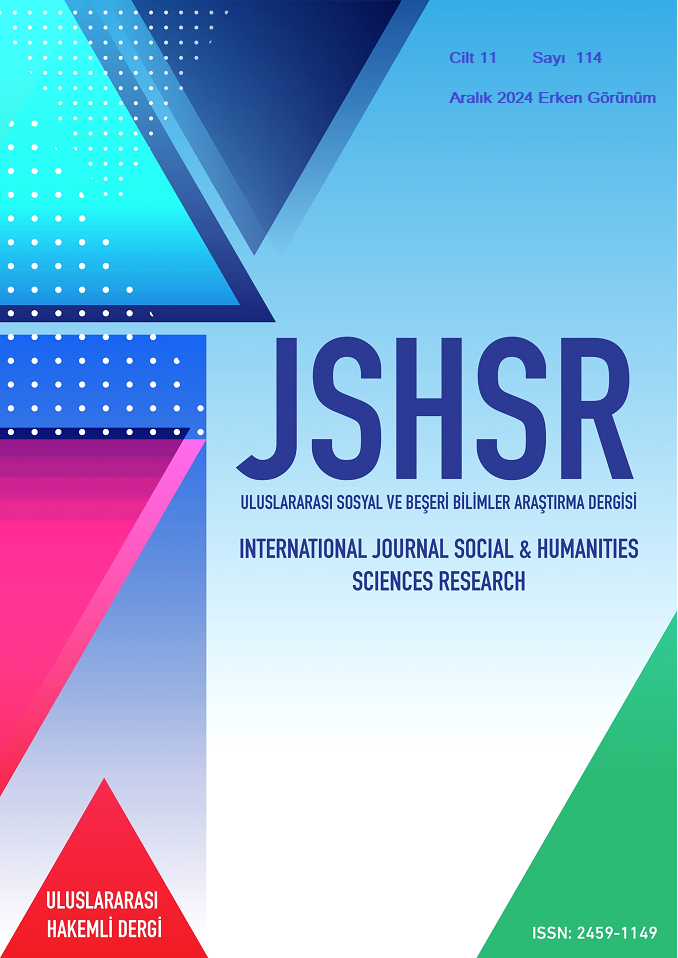Science Centers as the Spatial Reflection of Collective Future Though
DOI:
https://doi.org/10.5281/zenodo.14579781Keywords:
Science Centers, science museums, collective future, futureAbstract
Beyond being a physical place, space has a multidimensional structure as a manifestation of individual and social relationships, cultural ties, dreams and ideals. Space can carry the traces of the past into the present, as well as concretize the steps, dreams and concerns for the future. From the past to the present, people have produced spaces not only in accordance with their individual needs, but also with the idea of a collective future. The idea of a collective future refers to a future that a group, society, or humanity seeks to build together, in accordance with shared values, goals, and visions.
In 2008, the Scientific and Technical Research Council of Turkey (TÜBİTAK), which has the authority to establish and abolish science centers in Turkey and to approve the organizational charts of these institutions, called for the establishment and expansion of science centers throughout the country in order to disseminate science. Following this call, many large and small science centers have been opened in different provinces of the country since 2014, the first of which was in Konya, and many more are still being opened. These places, which have evolved from science museums to science centers, are fulfilling an important mission in our era where the development of technology has become an important factor of social, cultural and economic development all over the world. The aim of this study is to put forward the idea that these centers are part of a collective idea of the future, reflected both physically and ideologically in space. In this context, the definition of the idea of a collective future and its place in the literature are examined, and the history and development of science centers are discussed. In the case of the examples in Turkey, it is discussed how the design, organization, and functions of science centers represent not only the dissemination of scientific knowledge, but also the potential of communities to shape a common future together.
References
Accessto. (2024). Ontario Science Centre. https://www.accessto.ca/home/2016/12/8/ontario-science-centre
Altaş, A., & Uzun, F. V. (2017). Virtual museums and their use in the tourism sector: A case study in Turkey. International Journal of Social Humanities Sciences Research, 4(13), 1402–1418
Arayıcı, O. (2021). Mekânı Varlık Felsefesi Üzerinden Yeniden Tanımlamak. International Journal of Social and Humanities Sciences Research (JSHSR), 8(78), 3440–3444. https://doi.org/10.26450/ jshsr.2917
Arıoğlı, E. (1998). Bilgi Toplumuna Dönüşümün Müjdesi. http://www.tbmv.org/neden-bilim-merkezi.html
Bain, P. G., Hornsey, M. J., Bongiorno, R., Kashima, Y., & Crimston, C. R. (2013). Collective futures: How projections about the future of society are related to actions and attitudes supporting social change. Personality and Social Psychology Bulletin, 39(4), 523–539. https://doi.org/10.1177/ 0146167213478200
Bedini, S. A. (1965). The evolution of science museums. Technology and Culture, 6(1), 1–29.
Buckner, R. L. (2010). The role of the hippocampus in prediction and imagination. Annual Review of Psychology, 61(1), 27–48.
Cabinet de curiosités. (2024) https://fr.wikipedia.org/wiki/Cabinet_de_curiosit%C3%A9s
Feza Gürsey Bilim Merkezi (t.y.). Biz Kimiz. https://www.fgbm.com.tr/biz-kimiz/
Gregory, R. L. (2001). Hands-on science. Education for the Twenty-First Century, 181.
Hassabis, D., Kumaran, D., Vann, S. D., & Maguire, E. A. (2007). Patients with hippocampal amnesia cannot imagine new experiences. Proceedings of the National Academy of Sciences, 104(5), 1726–1731. https://doi.org/10.1073/pnas.0610561104
Kalkan, H., & Türk, C. (2017). Bilim merkezleri ve bilim müzelerinin tarihi. İçinde A. Güney (Ed.), Her yönüyle bilim merkezi. Çizgi Kitabevi.
Kimche, L. (1978). Science Centers: A Potential for Learning: Science centers are educational institutions designed around informal learning activities. Science, 199(4326), 270-273.
Klein, S. B., Loftus, J., & Kihlstrom, J. F. (2002). Memory and temporal experience: The effects of episodic memory loss on an amnesic patient's ability to remember the past and imagine the future. Social Cognition, 20(5), 353–379.
Koster, E. H. (1999). In search of relevance: Science centers as innovators in the evolution of museums. Daedalus, 128(3), 277–296.
Mert, N., & Wang, Q. (2023). Valance and perceived control in personal and collective future thinking. Future Studies Journal.
Oppenheimer, F. (1968). A rationale for a science museum. Curator, 11(3), 206–209.
Özcan, H., & Koştur, H. İ. (2017). Türkiye’de bilim merkezlerinin yasal statüsü. İçinde A. Güney (Ed.), Her yönüyle bilim merkezi (s. xx-xx). Çizgi Kitabevi.
Pedretti, E., & Navas Iannini, A. M. (2020). Towards fourth-generation science museums: Changing goals, changing roles. Canadian Journal of Science, Mathematics and Technology Education, 20, 700–714.
Polak, F., & Boulding, E. (1973). The image of the future. Elsevier.
Salmi, H. (1993). Science centre education: Motivation and learning in informal education. Research Report 119. Helsinki: University of Helsinki.
Szpunar, K. K., Spreng, R. N., & Schacter, D. L. (2014). A taxonomy of prospection: Introducing an organizational framework for future-oriented cognition. Proceedings of the National Academy of Sciences, 111(52), 18414–18421.
Szpunar, P. M., & Szpunar, K. K. (2016). Collective future thought: Concept, function, and implications for collective memory studies. Memory Studies, 9(4), 376–389. https://doi.org/10.1177/1750698015626046
Türkiye Bilimsel ve Teknolojik Araştırma Kurumu. (2019). Bilim merkezleri değerlendirme raporu. Ankara: TÜBA Yayınları. https://www.tuba.gov.tr/tr/yayinlar/suresiz-yayinlar/raporlar/bilim-merkezleri-degerlendirme-raporu-1
Türkiye Bilimsel ve Teknolojik Araştırma Kurumu (2017) 4003-A Çağrı Metni. Büyük ölçekli bilim merkezi kurulması projeleri. https://www.tubitak.gov.tr/tr/destekler/bilim-ve-toplum/ulusal-destek-programlari/icerik-4003-bilim-merkezi-kurulmasi-destek-programi
Türkiye Bilimsel ve Teknolojik Araştırma Kurumu (2010). Resmî Gazete (Sayı:27648). https://www.resmigazete.gov.tr/eskiler/2010/07/20100721-3.htm
Türkiye Bilimsel ve Teknolojik Araştırma Kurumu (t.y.). Bilim Merkezi Nedir? https://bilimmerkezleri.tubitak.gov.tr/Icerik/bilim-merkezi-nedir-140
Türkiye Bilimsel ve Teknolojik Araştırma Kurumu (2024). Bilim Merkezi Binaları Hakkında Temel Bilgilendirme Dokümanı. https://Bilimmerkezleri.Tubitak.Gov.Tr/Upload/Bmsinglefile/Dosya-876-477.Pdf
Tübitak Bilim Merkezleri (t.y.). Dünyadan Bilim Merkezleri. https://bilimmerkezleri.tubitak.gov.tr/ Icerik/dunyadan-bilim-merkezleri-141.
Weitze, M. D. (2003). Science centers: Examples from the US and from Germany. From the itinerant lecturers of the 18th century to popularizing physics in the 21st century–exploring the relationship between learning and entertainment, 58-66.https://en.wikipedia.org/wiki/Exploratorium
Wikipedia (2024). Exploratorium. https://en.wikipedia.org/wiki/Exploratorium
Downloads
Published
How to Cite
Issue
Section
License
Copyright (c) 2024 INTERNATIONAL JOURNAL OF SOCIAL HUMANITIES SCIENCES RESEARCH

This work is licensed under a Creative Commons Attribution 4.0 International License.


